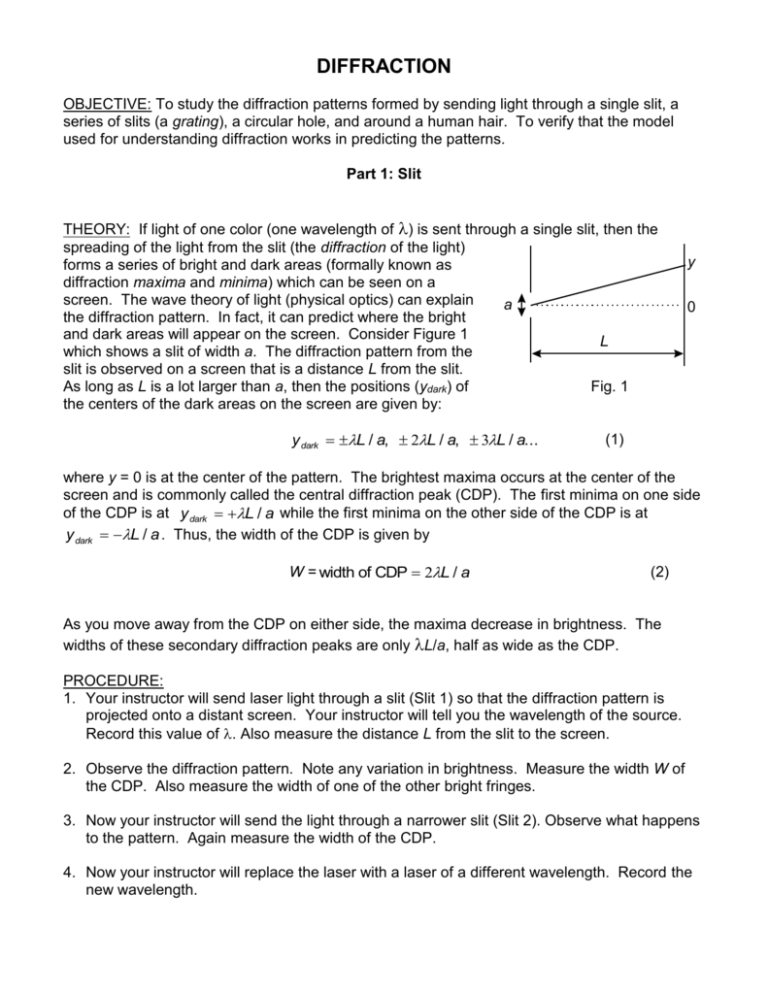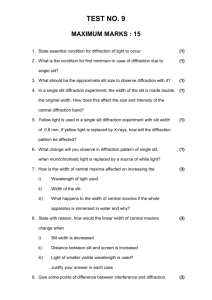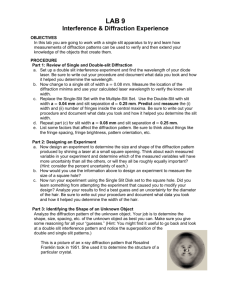Diffraction
advertisement

DIFFRACTION OBJECTIVE: To study the diffraction patterns formed by sending light through a single slit, a series of slits (a grating), a circular hole, and around a human hair. To verify that the model used for understanding diffraction works in predicting the patterns. Part 1: Slit THEORY: If light of one color (one wavelength of ) is sent through a single slit, then the spreading of the light from the slit (the diffraction of the light) forms a series of bright and dark areas (formally known as diffraction maxima and minima) which can be seen on a screen. The wave theory of light (physical optics) can explain a the diffraction pattern. In fact, it can predict where the bright and dark areas will appear on the screen. Consider Figure 1 L which shows a slit of width a. The diffraction pattern from the slit is observed on a screen that is a distance L from the slit. As long as L is a lot larger than a, then the positions (ydark) of Fig. 1 the centers of the dark areas on the screen are given by: y dark L / a, 2L / a, 3L / a... y 0 (1) where y = 0 is at the center of the pattern. The brightest maxima occurs at the center of the screen and is commonly called the central diffraction peak (CDP). The first minima on one side of the CDP is at y dark L / a while the first minima on the other side of the CDP is at y dark L / a . Thus, the width of the CDP is given by W = width of CDP 2L / a (2) As you move away from the CDP on either side, the maxima decrease in brightness. The widths of these secondary diffraction peaks are only L/a, half as wide as the CDP. PROCEDURE: 1. Your instructor will send laser light through a slit (Slit 1) so that the diffraction pattern is projected onto a distant screen. Your instructor will tell you the wavelength of the source. Record this value of . Also measure the distance L from the slit to the screen. 2. Observe the diffraction pattern. Note any variation in brightness. Measure the width W of the CDP. Also measure the width of one of the other bright fringes. 3. Now your instructor will send the light through a narrower slit (Slit 2). Observe what happens to the pattern. Again measure the width of the CDP. 4. Now your instructor will replace the laser with a laser of a different wavelength. Record the new wavelength. Diffraction 2 5. Your instructor will send the new laser light through the original slit (Slit 1). Again measure the width of the CDP. 6. Now the light will be sent through the Slit 2. Again measure the CDP width. REPORT: 1. Is the CDP twice as wide as the other bright fringes as predicted? Do the bright fringes have equal brightness? If not, describe the variation in brightness. 2. What happens to the pattern as the slit gets narrower? Is this consistent with the wave theory of light that models diffraction? 3. What happens to the pattern as the wavelength of the light is reduced? Is this expected? 4. Use Eq. (2) to calculate the slit width (a) for Slit 1. Calculate two values for a, one for each of the laser wavelengths. Express the distances in millimeters. Remember that: 1 mm (millimeter) = 1x10-3 m 1m (micron) = 1x10-6 m 1 nm = 1x10-9 m Ideally, the two values should be equal. Are your values close to each other? What could cause a discrepancy? 5. Repeat the calculations of a for Slit 2. Again comment on the agreement of the two values. 6. Could you see a resolvable diffraction pattern coming from the doorway if you expanded the laser beam large enough so that it overfilled the doorway? What about if you did the same thing with radio waves? Part 2: Grating THEORY: If instead of one slit, you illuminate a series of many parallel slits that are spaced close together, then the resulting diffraction pattern from the collection of slits becomes slightly different. In fact, it looks very much like the interference pattern y from two slits except that the bright fringes are much narrower and brighter. Again, the wave theory of light is successful in d predicting the pattern. Consider Figure 2 which shows a grating 0 whose slits are separated by a distance d. The diffraction pattern from the grating is observed on a screen that is a L distance L from the slits. The angles at which the bright peaks are seen are given by the grating equation: Fig. 2 d sinm m (3) where m = 0, ±1, ±2,…. The integer m is called the order number. For example, there is a bright peak at = 0 which corresponds to the zeroth order diffraction peak (m = 0). This is right Diffraction 3 at the center of the pattern. The first order diffraction peak is then at angle 1 given by m = 1 in Eq. (3). There is a corresponding peak at an equal angle below the center of the pattern given by m = -1. The positions y of the bright peaks are related to the angles and the distance L through the tangent function, tanm y m / L (4) PROCEDURE: 1. Your instructor will send laser light through a grating so that the diffraction pattern is projected onto a distant screen. Your instructor will tell you the wavelength of the source. Record this value of . Also measure the distance L from the slit to the screen. 2. Observe the diffraction pattern. Describe what you see on the screen. 3. Measure the distance from the center peak to the first order peak on the right side. This is y+1. Now measure the distance from the center peak to the first order peak on the left. This is y-1. REPORT: 1. Are your values of y+1 and y-1 equal? Should they be? Find the average of these two values and use this average y in Eq. (4) to calculate for the grating. Use this value of and the wavelength in the grating equation, Eq. (4), to find the slit separation d. Express the distance in millimeters. 2. Take the reciprocal of d to find the grating constant. 3. The manufacturer of the grating states that the grating constant is 600 line/mm. Compare your value to this nominal value. What could cause any discrepancies? 4. Describe a possible application of a grating. Part 3: Circular Hole THEORY: If light of one color (one wavelength of ) is sent through a circular hole, then the diffraction pattern observed on a screen appears as a very bright disk surrounded by larger and larger dark and bright circular rings. The bright disk is at the center of the pattern and is sometimes called the Airy disk after the scientist who successfully used the wave theory of light to model the formation of the diffraction pattern. The rings are called the Airy rings. The rings get dimmer and dimmer as they increase in size. The width of the Airy disk decreases as do the diameters of the rings as the circular hole increases in size. Eventually, when the hole is large enough, you only see one bright spot because the disk and rings are so close together. While the wave model of light does give us equations for the diameters of the Airy disk and rings, we will only observe the patterns qualitatively in this experiment. Diffraction 4 PROCEDURE: 1. Your instructor will send laser light through a circular aperture so that the diffraction pattern is projected onto a distant screen. Your instructor will tell you the wavelength of the source. Record this value of . 2. Make a sketch of what you see. Label the Airy disk on your sketch. Is the Airy disk the brightest part of the pattern? 3. Your instructor will now use a circular hole with a larger diameter. Again observe the pattern. What happened to the pattern? Is this consistent with what was described in the Theory section? Is this consistent with what happens to the diffraction pattern of a single slit if the slit width is increased? REPORT: 1. Record your observations as directed in the Procedure and answer the questions raised there. Part 4: Strand of Hair THEORY: If light hits a small enough obstacle, it will bend around the object and spread out as it travels away from the object. This is also diffraction. Here, you will use a strand of hair for the object. The pattern formed by the long, thin hair is similar to that formed by light that passes through a long, thin slit. In fact, you will use Eq. (2) to calculate the width of the hair. PROCEDURE: 1. Your instructor will set up a laser so that the emitted light strikes a strand of hair. Your instructor will tell you the wavelength of the source. Record this value of . 2. Measure the width W of the CDP as you did for the slit pattern. Also, measure the distance L from the hair to the screen. REPORT: 1. Using Eq. (2), calculate the width of the hair, a. Express your answer in microns. 2. Is this width for the hair seem reasonable? 3. If the strand was replaced by a strand of thicker hair, what would happen to the diffraction pattern on the screen?








